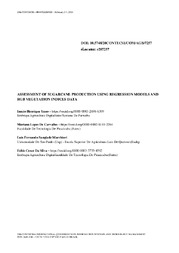Assessment of sugarcane production using regression models and RGB vegetation indices data.
Assessment of sugarcane production using regression models and RGB vegetation indices data.
Author(s): YANO, I. H.; CARVALHO, M. L. de M; MARCHIORI, L. F. S.; SILVA, F. C. da
Summary: Productivity estimates play a crucial role for sugarcane producers and sugar mills in planning production, aligning it with demand forecasts. Manual estimations demand considerable effort and time, prompting exploration into alternative productivity estimation methods such as aerial imaging using drones. Within imaging techniques, productivity estimation occurs indirectly through the analysis of vegetation indices. The widely recognized vegetation index, NDVI, necessitates costly near-infrared (NIR) cameras, making it inaccessible to many producers. Our approach utilized drone imagery captured by more affordable RGB cameras, which are feasible for a larger number of producers. We applied six regression models alongside a stacking model that amalgamated these six models for estimating sugarcane production using the eight RGB vegetation indices. Initial tests revealed a Mean Absolute Percentage Error (MAPE) of less than 13%. This level of accuracy is considered favorable when benchmarked against similar studies and presents encouraging prospects for future research.
Publication year: 2024
Types of publication: Paper in annals and proceedings
Observation
Some of Embrapa's publications are published as ePub files. To read them, use or download one of the following free software options to your computer or mobile device. Android: Google Play Books; IOS: iBooks; Windows and Linux: Calibre.
Access other publications
Access the Agricultural Research Database (BDPA) to consult Embrapa's full library collection and records.
Visit Embrapa Bookstore to purchase books and other publications sold by Embrapa.

